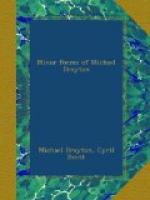the Miseries of Queene Margarite and of the
Moone-Calfe we have already spoken. The
most notable piece in the book is the Nimphidia.
This poem of the Court of Fairy has ‘invention,
grace, and humour’, as Canon Beeching has said.
It would be interesting to know exactly when it was
composed and committed to paper, for it is thought
that the three fairy poems in Herrick’s Hesperides
were written about 1626. In any case, Drayton’s
poem touches very little, and chiefly in the beginning,
on the subject of any one of Herrick’s three
pieces. The style, execution, and impression left
on the reader are quite different; even as they are
totally unlike those of the Midsummer Night’s
Dream. Herrick’s pieces are extraordinary
combinations of the idea of ‘King of Shadows’,
with a reality fantastically sober: the poems
are steeped in moonlight. In Drayton all is clear
day, or the most unromantic of nights; though everything
is charming, there is no attempt at idealization,
little of the higher faculty of imagination; but great
realism, and much play of fancy. Herrick’s
verses were written by Cobweb and Moth together, Drayton’s
by Puck. Granting, however, the initial deficiency
in subtlety of charm, the whole poem is inimitably
graceful and piquant. The gay humour, the demure
horror of the witchcraft, the terrible seriousness
of the battle, wonderfully realize the mock-heroic
gigantesque; and while there is not the minute accuracy
of Gulliver in Lilliput, Drayton did not write for
a sceptical or too-prying audience; quite half his
readers believed more or less in fairies. In
the metre of the poem Drayton again echoes that of
the older romances, as he did in Dowsabel.
In the Quest of Cinthia, while ostensibly we
come to the real world of mortals, we are really in
a non-existent land of pastoral convention, in the
most pseudo-Arcadian atmosphere in which Drayton ever
worked. The metre and the language are, however,
charmingly managed. The Shepheards Sirena is
a poem, apparently, ‘where more is meant than
meets the ear,’ as so often in pastoral poetry[23];
it is difficult to see exactly what is meant; but
the Jacobean strain of doubt and fear is there, and
the poem would seem to have been written some time
earlier than 1627. The Elegies comprise
a great variety of styles and themes; some are really
threnodies, some verse-letters, some laments over the
evil times, and one a summary of Drayton’s literary
opinions. He employs the couplet in his Elegies
with a masterly hand, often with a deliberately rugged
effect, as in his broader Marstonic satire addressed
to William Browne; while the line of greater smoothness
but equal strength is to be seen in the letters to
Sandys and Jeffreys. He is fantastic and conceited
in most of the threnodies; but, as is natural, that
on his old friend, Sir Henry Rainsford, is least artificial
and fullest of true feeling. The epistle to Henery
Reynolds. Of Poets and Poesie shows Drayton
as a sane and sagacious critic, ready to see the good,
but keen to discern the weakness also; perhaps the
clearest evidence of his critical skill is the way
in which nearly all of his judgements on his contemporaries
coincide with the received modern opinions.




